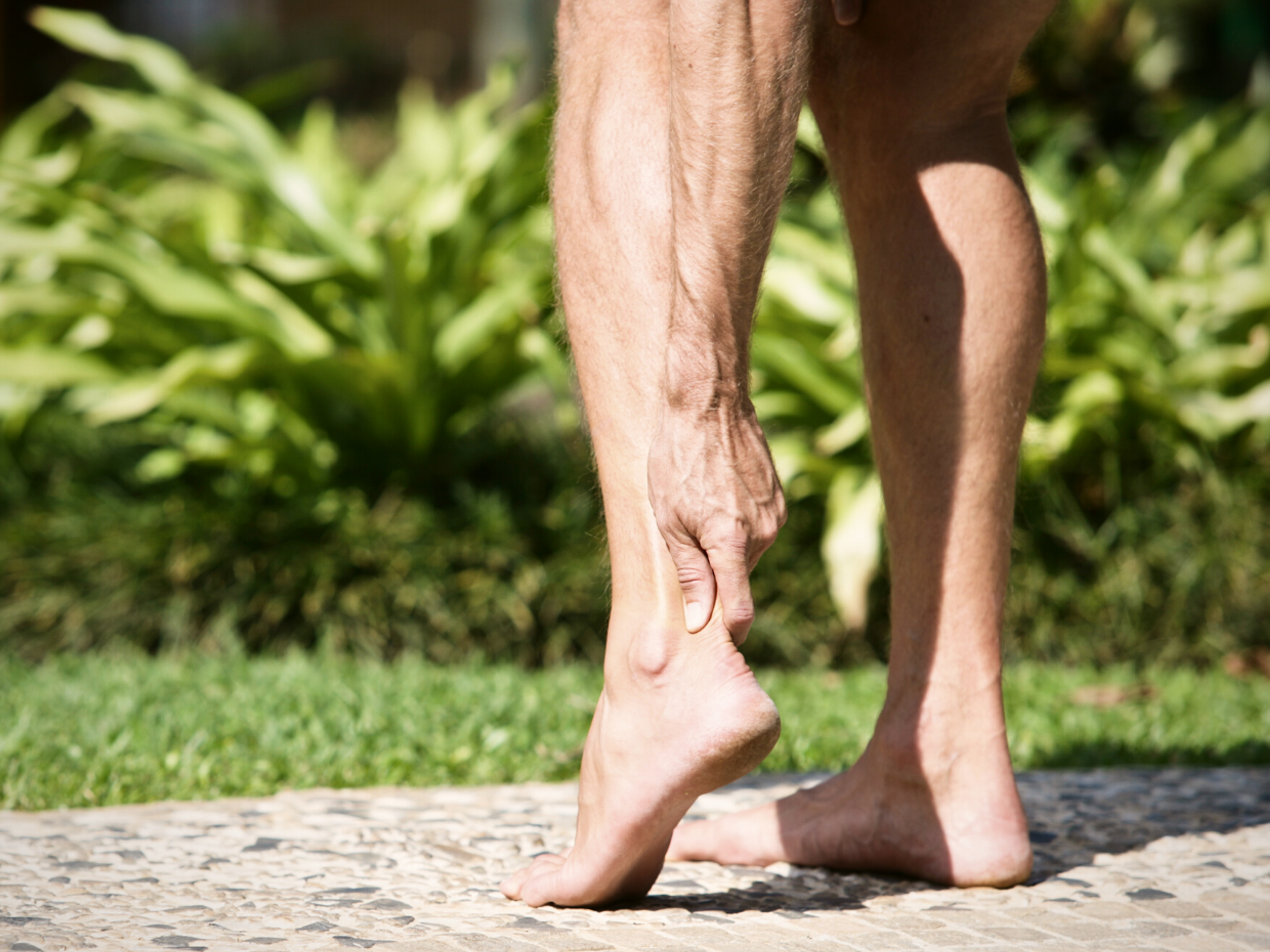Achilles tendonitis stretches not helping? Find out why (and 3 effective alternatives to try instead)
This article explains how stretching affects your Achilles tendon, why stretching may work against you, and what you can do if it’s not helping.
Let’s start with why people stretch their Achilles tendons in the first place.
Why people do stretches for Achilles tendonitis
There’s a common misconception that tight calves cause Achilles tendonitis. This is likely because your calves can feel very tight when your Achilles is injured, so people assume stretches will help relieve their symptoms.
However, research on tendon injuries doesn’t support this treatment approach.
Having tight calves doesn’t lead you to developing Achilles tendonitis.
Tight calves do not cause Achilles tendonitis
The evidence clearly indicates that the most common cause of Achilles tendinopathy or tendonitis is overloading the tendon – not just tight calf muscles.
Tendon overload usually happens when you:
- Do too much of an activity that works your tendon, or
- Do not allow your tendon enough recovery time between bouts of exercise.
We will talk about how this relates to stretches later on.
Cause or result?
What causes calf and Achilles stiffness in Achilles tendonitis?
The tightness you feel when you have Achilles tendonitis isn’t the same as the stiff and sore muscles you get after exercising – you can’t stretch this type of tightness out.
Achilles tendonitis-related calf and tendon tightness is caused by:
- Excess fluid accumulating in your tendon due to your injury, and
- the injured tendon irritating your calf muscles, causing them to stiffen up.
Next, we’ll look at the most common Achilles tendonitis stretches, their impact on your injury, and what other treatment options may work better.
Most common Achilles tendonitis stretches
Any movement that takes your ankle into dorsiflexion (toes-to-shin movement) will stretch your calf muscles and Achilles tendon.
The most frequently recommended stretches for Achilles tendonitis include:
- The typical runner’s calf stretch
- Seated calf stretch, pulling your toes toward your shin (with or without a band)
- Heel drops (heels over the edge of a step)
- Downward dog pose in yoga
Does stretching help Achilles tendonitis?
Evidence shows that when you have Achilles tendonitis, these types of stretches can worsen your condition. Also, when your tendon is injury-free, overstretching your Achilles tendon can cause Achilles tendinitis, too.
So, doing stretches at the wrong time in your rehab or the wrong way is not helpful for Achilles tendonitis.
How can stretches cause or aggravate Achilles tendonitis?
Remember the concept of tendon overload from earlier?
Just as excessive tendon-loading exercises and activities or insufficient rest between sessions can overload your tendon and lead to Achilles tendonitis, overstretching your tendon can, too.
Here’s how this happens and how it can show up:
1. Achilles tendon stretches compress your tendon
When you do calf or Achilles stretches, the lower part of your Achilles tendon becomes compressed against your heel bone. This is normal and usually not a problem.
However, if this compression becomes excessive, it can injure that part of the tendon and lead to Achilles tendonitis. This can happen when you:
- Stretch your calves and Achilles too forcefully, or
- sustain these stretches for a long time.
Excessive tendon compression is considered one of the primary causes of insertional Achilles tendonitis.
If you’re a runner, you can avoid this issue by learning how to stretch your calves safely and effectively before and after running.
2. Injured tendons are more sensitive to compression
Injured tendons are much more sensitive to compression than uninjured ones, so even gentle stretching can flare them up.
That’s why avoiding or limiting exercises that stretch your calf and Achilles tendon during the early rehab stages when you have Achilles tendonitis is better.
For instance, you can do your calf raises or heel drops on the floor instead of over the edge of a step, reducing the stretch of your tendon.
This slight change in position can help you strengthen your tendon without irritating it and is especially helpful if you have insertional Achilles pain.
3. Calf and Achilles stretches can cause a delayed pain response
Tendons often have a delayed pain response. So, although it may feel like they’re helping initially, they can lead to more pain and stiffness several hours later.
Knowing when and how to stretch correctly for your type of Achilles tendonitis injury is crucial for your recovery.
The Exakt Health app helps with this by offering two separate rehab plans: One for insertional Achilles tendinopathy and another for mid-portion Achilles tendinopathy. That way, you know you’re getting the most appropriate advice for your condition.
Stretches aren’t always a good option when you have Achilles tendonitis, so finding other ways to ease discomfort can help.
Effective alternatives to Achilles tendonitis stretches
1. Foam rolling or massage
Foam rolling or massage can help to relieve your calf muscle tension and tightness. Focusing on your calf muscles and avoiding the Achilles tendon can help you find relief without stretching or irritating your tendon injury.
Gentle repetitive movements
Gentle movements and exercises like foot pumps (moving your foot and toes up and down) or slow double-leg calf raises can improve circulation in the area, easing Achilles soreness and stiffness.
Note: It’s essential to understand that massages and gentle movement may help to decrease your symptoms temporarily, but the tight, stiff feeling in your calf and Achilles will only fully disappear once your tendon has healed.
Strengthening exercises
Exercise that strengthens your Achilles tendon is the best way to recover effectively from Achilles tendonitis.
Strengthening your calf muscles and Achilles tendon as a unit will help them handle your daily activities and sports demands, allowing a safe return to what you love.
Although there are many strengthening exercise options, it’s vital to choose the right starting level and progressively increase the intensity as your tendon grows stronger.
This blog post shows you how to correctly choose, start, and progress your Achilles tendonitis exercises.
Should you stretch with Achilles tendonitis (when can you start)?
Although stretches can cause or aggravate an Achilles tendon injury, stretching isn’t entirely out of the question for Achilles tendonitis—you should just do them carefully.
Knowing whether you should do Achilles tendon stretches or when to start will depend on how sensitive your tendon is.
A general rule is that if you have pain during or after Achilles tendon stretches, it’s best to avoid them until:
- Your pain has settled, and
- your tendon has built enough strength to handle stretching.
The Exakt Health app guides you through this process and uses your feedback to decide when it’s safe for you to include more vigorous stretches.
Quick overview and FAQs about Achilles tendonitis and stretching
Conclusion
Hopefully, this article has clearly explained why stretches may not be the best way to relieve stiffness and pain associated with Achilles tendonitis.
Other helpful takeaway points are:
- Your long-term goal should be strengthening your tendon rather than simply stretching it.
- The key to effective Achilles tendonitis rehab exercises is choosing the right exercises for your type of injury, starting at the right level, and progressing appropriately as your tendon grows stronger.
Want to learn more about each Achilles tendonitis rehab plan? Head over to our Mid-portion and Insertional Achilles tendonitis plan pages, where we answer all you need to know about the programs and more.
All the best with your recovery!




